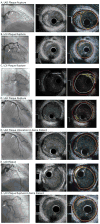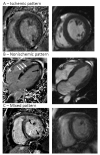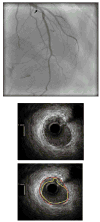Mechanisms of myocardial infarction in women without angiographically obstructive coronary artery disease
- PMID: 21900087
- PMCID: PMC3619391
- DOI: 10.1161/CIRCULATIONAHA.111.026542
Mechanisms of myocardial infarction in women without angiographically obstructive coronary artery disease
Abstract
Background: There is no angiographically demonstrable obstructive coronary artery disease (CAD) in a significant minority of patients with myocardial infarction, particularly women. We sought to determine the mechanism(s) of myocardial infarction in this setting using multiple imaging techniques.
Methods and results: Women with myocardial infarction were enrolled prospectively, before angiography, if possible. Women with ≥50% angiographic stenosis or use of vasospastic agents were excluded. Intravascular ultrasound was performed during angiography; cardiac magnetic resonance imaging was performed within 1 week. Fifty women (age, 57±13 years) had median peak troponin of 1.60 ng/mL; 11 had ST-segment elevation. Median diameter stenosis of the worst lesion was 20% by angiography; 15 patients (30%) had normal angiograms. Plaque disruption was observed in 16 of 42 patients (38%) undergoing intravascular ultrasound. There were abnormal myocardial cardiac magnetic resonance imaging findings in 26 of 44 patients (59%) undergoing cardiac magnetic resonance imaging, late gadolinium enhancement (LGE) in 17 patients, and T2 signal hyperintensity indicating edema in 9 additional patients. The most common LGE pattern was ischemic (transmural/subendocardial). Nonischemic LGE patterns (midmyocardial/subepicardial) were also observed. Although LGE was infrequent with plaque disruption, T2 signal hyperintensity was common with plaque disruption.
Conclusions: Plaque rupture and ulceration are common in women with myocardial infarction without angiographically demonstrable obstructive coronary artery disease. In addition, LGE is common in this cohort of women, with an ischemic pattern of injury most evident. Vasospasm and embolism are possible mechanisms of ischemic LGE without plaque disruption. Intravascular ultrasound and cardiac magnetic resonance imaging provide complementary mechanistic insights into female myocardial infarction patients without obstructive coronary artery disease and may be useful in identifying potential causes and therapies. Clinical Trial Registration- URL: http://www.clinicaltrials.gov. Unique identifier: NCT00798122.
Conflict of interest statement
Figures





Comment in
-
What causes myocardial infarction in women without obstructive coronary artery disease?Circulation. 2011 Sep 27;124(13):1404-6. doi: 10.1161/CIRCULATIONAHA.111.055855. Circulation. 2011. PMID: 21947933 Free PMC article. No abstract available.
-
Letter by Chen and Zhang regarding article, "mechanisms of myocardial infarction in women without angiographically obstructive coronary artery disease".Circulation. 2012 Aug 7;126(6):e81; author reply e83. doi: 10.1161/CIRCULATIONAHA.111.076893. Circulation. 2012. PMID: 22869863 No abstract available.
-
Letter by Ward and Figtree article, "mechanisms of myocardial infarction in women without angiographically obstructive coronary artery disease".Circulation. 2012 Aug 7;126(6):e82; author reply e83. doi: 10.1161/CIRCULATIONAHA.111.077925. Circulation. 2012. PMID: 22869864 No abstract available.
References
-
- Hochman JS, Tamis JE, Thompson TD, Weaver WD, White HD, VandeWerf F, Aylward P, Topol EJ, Califf RM. Sex, clinical presentation, and outcome in patients with acute coronary syndromes. N Engl J Med. 1999;341:226–232. - PubMed
-
- Gehrie ER, Reynolds HR, Chen AY, Neelon BH, Roe MT, Gibler WB, Ohman EM, Newby LK, Peterson ED, Hochman JS. Characterization and outcomes of women and men with non-ST-segment elevation myocardial infarction and nonobstructive coronary artery disease: results of the CRUSADE quality improvement initiative. Am Heart J. 2009;158:688–694. - PubMed
-
- Chokshi NP, Iqbal SN, Berger RL, Hochman JS, Feit F, Slater JN, Pena-Sing I, Yatskar L, Keller NM, Babaev A, Attubato MJ, Reynolds HR. Sex and race are associated with the absence of epicardial coronary artery obstructive disease at angiography in patients with acute coronary syndromes. Clin Cardiol. 2010;33:495–501. - PMC - PubMed
-
- Nageh T, Sherwood RA, Wainwright RJ, Shah AM, Thomas MR. The clinical relevance of raised cardiac troponin I in the absence of significant angiographic coronary artery disease. Int J Cardiol. 2005;100:325–330. - PubMed
Publication types
MeSH terms
Associated data
Grants and funding
LinkOut - more resources
Full Text Sources
Medical
Miscellaneous

